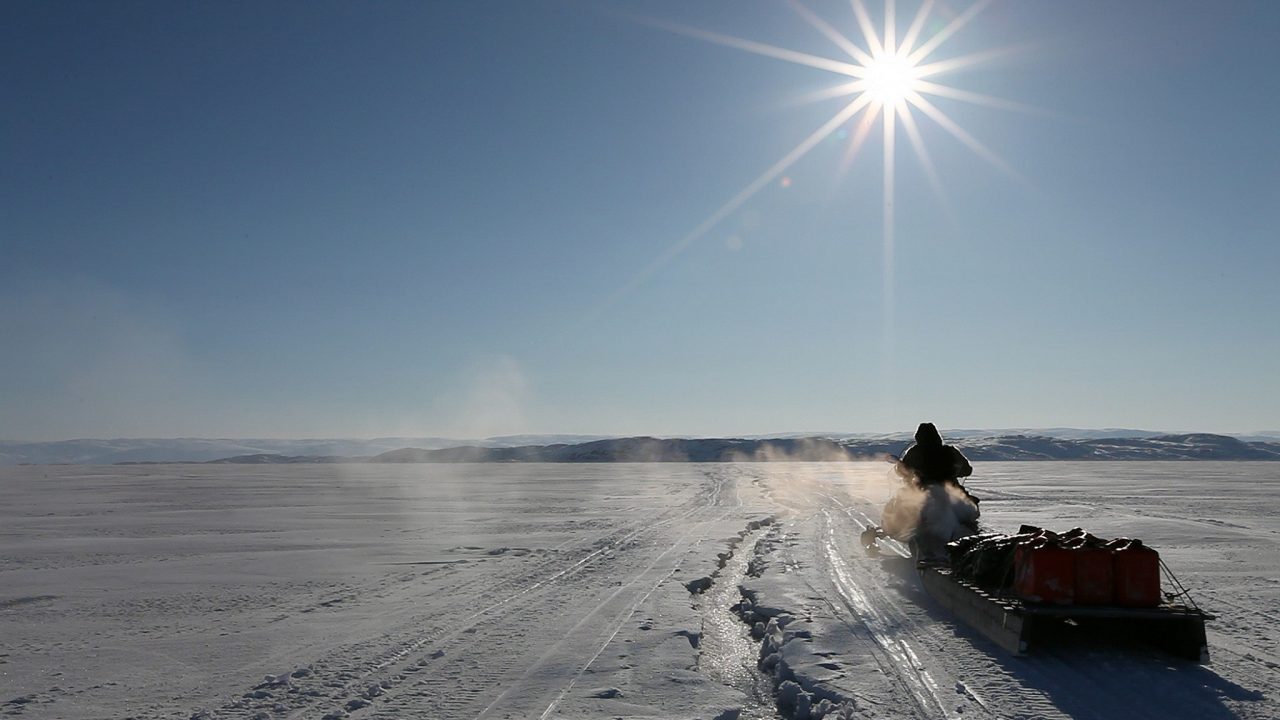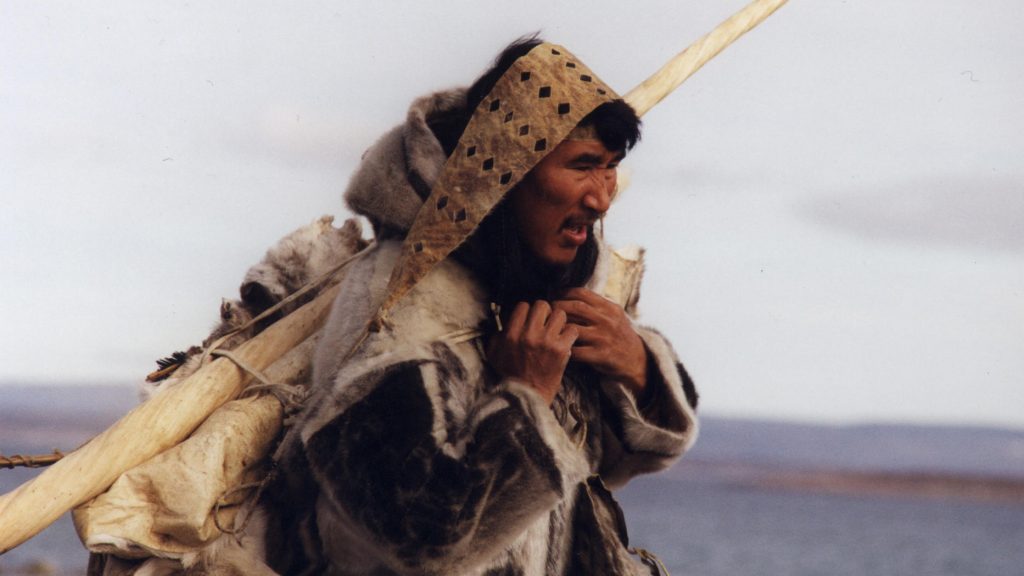
Inuit Cinema at the NFB | Curator’s Perspective
Inuit Cinema at the NFB | Curator’s Perspective
This week’s NFB.ca debut of the documentary Evan’s Drum (2021), by Inuk filmmaker Ossie Michelin, provides an opportunity to give an overview of Inuit cinema at the NFB.
But before we get into the first of these films, shot in the 1970s, we need to step back and take a look at the three previous decades, so we can better understand the context in which those first films were made.
Myths and stereotypes
The people and landscapes of the Far North had fascinated settlers since the arrival of Europeans in North America in the 16th century. The Arctic was always depicted as an almost mythical place—one that was exotic and untouched. This depiction persisted, from the accounts of British explorers Martin Frobisher and Sir John Franklin, and the Scandinavians Vilhjalmur Stefansson and Knud Rasmussen, through to the images of Robert Flaherty’s famous 1922 documentary Nanook of the North and the documentary tradition that followed it—as well as in literature, popular imagery, Hollywood films, and photography. In short, the Far North became a dreamscape onto which white men projected their fantasies of purity and exoticism.
Western culture created a mythical vision of these vast spaces, and stereotypes of their inhabitants. In the collective settler imagination, the “Eskimo,” the inappropriate term used at the time, quickly became a primitive figure with an incredible capacity for adaptation, able to live happily in a hostile environment and under the most extreme conditions.
Inuit before Inuit cinema
During the 1940s and 1950s, the NFB sent film crews to the Northwest Territories and Baffin Island to record images of Inuit. The resulting films were intended to document their arts, craftsmanship and way of life, but instead presented Inuit as exotic curiosities: tireless workers and experienced hunters and fishers, who, in the eyes of these non-Inuit filmmakers, lived in perfect harmony with nature. Inuit were depicted as having simple but effective tools, and living in keeping with their beliefs and traditions, all while easily adapting to the changes brought by the white man.
Eskimo Arts and Crafts, Laura Boulton, provided by the National Film Board of Canada
During the 1960s, NFB filmmakers became very interested in the relationships between white and Inuit cultures, but always from the viewpoint that Inuit were benefiting from western culture, religion and lifestyle. These films come from the perspective of a desire for Inuit culture to be assimilated.
The first films
In 1971, the Government of Canada announced its multiculturalism policy, which recognized Canada’s ethnic diversity, affirmed the status of English and French as the country’s two official languages, and recognized the rights of Indigenous people. Following this announcement, the NFB, in collaboration with the Ministry of Indian and Northern Affairs and the Government of the Northwest Territories, established a series of documentary and animation training and production workshops for Inuit.
Sikusilarmiut
In October 1972, the English Program Animation Studio launched the Arctic Film Workshop in Cape Dorset, an Arctic centre for culture and events. Training sessions in animation were held there, with the participation of a dozen young Inuit. These budding animators quickly started producing films. The workshop was called Sikusilarmiut, which in English means “the People from the place where the ice meets the sea.” Dozens of films came out of it, using a range of animation techniques including paper cut-outs, photo collage, pixilation, traditional drawing and sand on glass. The films were shot onsite, with the material then sent to the NFB in Montreal for processing, before being returned to Cape Dorset. The editing, sound effects and soundtrack were all done at the workshop by the filmmakers. The narration was in Inuktitut and English. This workshop introduced the talents of many Inuit filmmakers to the world, including Timmun Alariaq, Pitaloosie, Sorosilutoo, Mathew Joanasie and Solomonie Joe Pootoogook—all trailblazers in the world of Inuit animated film. The Animation from Cape Dorset (1973) collection is a compilation of some of these films.
Animation from Cape Dorset, , provided by the National Film Board of Canada
The Frobisher Bay Workshop
The animation workshops were a success, but documentary was not about to be outdone. A year later, the English Program—again with the support of the Ministry of Indian and Northern Affairs—launched a documentary workshop in Frobisher Bay (now Iqaluit), simply called the Frobisher Bay Workshop. It is hard to confirm exactly how many Inuit filmmakers participated in this workshop and how many films came out of it. But we do know about three films for sure: Natsik Hunting (1975), Whale Hunting (Qilaluganiatut, 1977) and Asivaqtiin (The Hunters, 1977). The heritage value of these films—which were shot, edited, narrated and directed by Mosha Michael—is priceless. They are the first documentaries by an Inuk filmmaker, making Michael the first Inuk documentarian in Canada.
The Hunters (Asivaqtiin), Mosha Michael, provided by the National Film Board of Canada
The great silence
Unfortunately, these workshops did not continue. Inuit cinema had just taken its first steps and now was reduced to a deafening silence. In the 1980s and 1990s, non-Inuit filmmakers from the NFB’s English and French programs took it upon themselves to speak for Inuit. Films from this era often came to the defence of Inuit by supporting the protection of their territory (Our Land, Our Truth, 1983); promoting their rights (Dancing Around the Table, 1985), highlighting their culture (Lypa, 1988), bearing witness to their history (The Last Days of Okak, 1985; Broken Promises: The High Arctic Relocation, 1995) and highlighting the dangers and challenges they faced (Between Two Worlds, 1990). But you won’t find the names of any Inuit filmmakers in the credits of these films.
The creation of Nunavut
The creation of the new territory of Nunavut on April 1, 1999, coincided with a re-emergence of Inuit cinema. Documentary filmmaker Martin Kreelak’s Amarok’s Song: Journey to Nunavut (1998) refers to this historic event. Kreelak tells the story of his family—one of the last nomadic families in Canada—and of their return to Nunavut. French Program also was a part of this re-emergence, releasing two documentaries by young filmmakers: Bobby Kenuajuak and Elisapie Isaac. The first, My Village in Nunavik (1999), traces the history of the filmmaker’s village, Puvirnituq, and its inhabitants, while the latter, If the Weather Permits (2003), hinges on the relationship between modernity and tradition, and the survival of Inuit culture. Inuuvunga: I Am Inuk, I Am Alive (2004) shares the point of view of eight young Inuit teen filmmakers on contemporary life in the Canadian North.
If the Weather Permits, Elisapie Isaac, provided by the National Film Board of Canada
And the film Atanarjuat: The Fast Runner (2000), by Zacharias Kunuk, left no doubt about the return of Inuit cinema. This Inuktitut-language feature drama was strikingly beautiful and poetic. It was almost entirely written, filmed and produced by an Inuit crew, featuring Inuit actors, and offers an authentic point of view from within the culture. The film won the Caméra d’or at the 2001 Cannes Film Festival.

The 2010s
The production of Inuit films continued during the following decade. English Program’s Edmonton and Winnipeg studios launched a series of documentary short films called Stories from Our Land (2011) and Stories from Our Land Vol. 2 (2013), as well as a series of animated shorts called Nunavut Animation Lab (2010). Two notable feature-length documentaries from this era attest to the return of Inuit film: Ole Gjerstad and Joelie Sanguya’s Qimmit: A Clash of Two Truths (2010), about the massacre of sled dogs (a key method of transport for Inuit) by the RCMP in the 1960s, and Alethea Arnaquq-Baril’s excellent Angry Inuk (2016), on the importance of the ancestral practice of the seal hunt. Animation filmmaking stormed back too, with Shaman (2017) by Echo Henoche and the very beautiful Three Thousand (2017) by Assinajaq, which brings together archival images and animation to recount 3,000 years of Inuit history.
Three Thousand, Asinnajaq, provided by the National Film Board of Canada
The future of Inuit cinema at the NFB seems promising. We’re still in the early part of this new decade, but four films by Inuit filmmakers have already been completed: Being Prepared (2021) by Carol Kunnuk, Evan’s Drum (2021) by Ossie Michelin, Nalujuk Night (2021) by Jennie Williams, and Arctic Song (2021) by Germaine Arnattaujuq, Neil Christopher and Louise Flaherty.
I invite you to enjoy our selection of Inuit films here.



